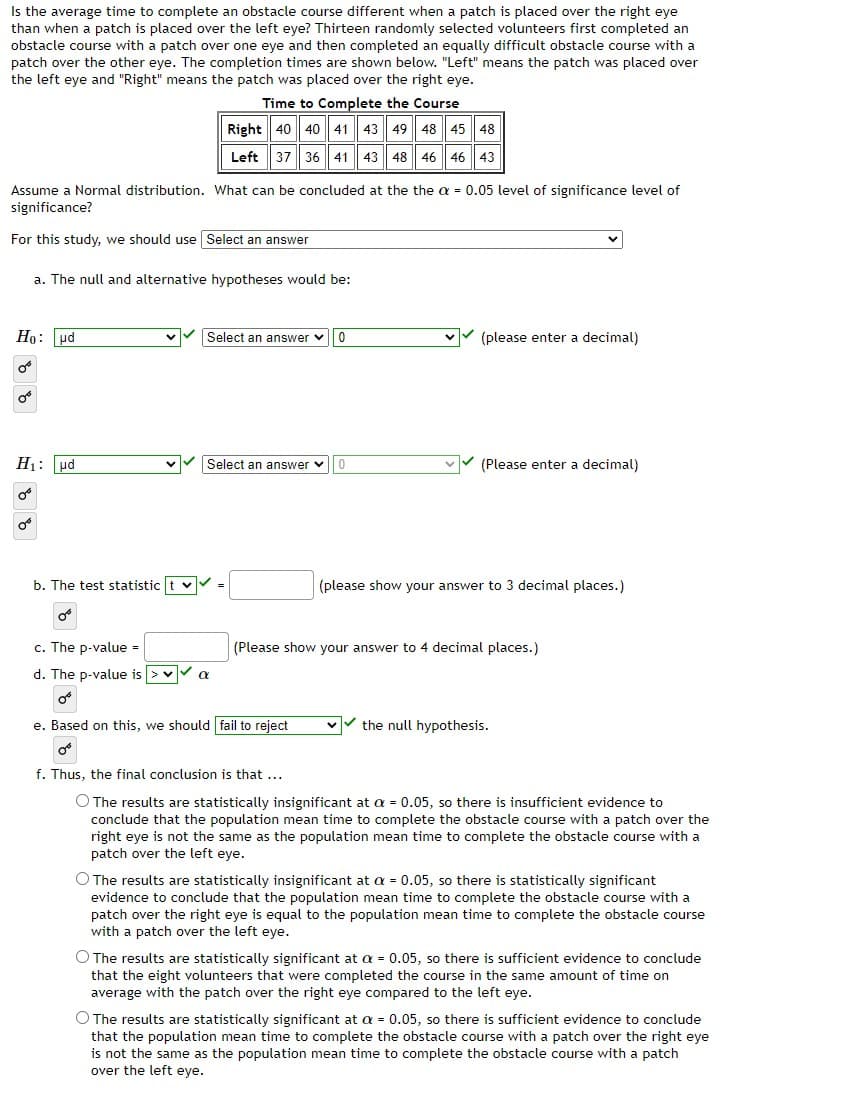Is the average time to complete an obstacle course different when a patch is placed over the right eye than when a patch is placed over the left eye? Thirteen randomly selected volunteers first completed an obstacle course with a patch over one eye and then completed an equally difficult obstacle course with a patch over the other eye. The completion times are shown below. "Left" means the patch was placed over the left eye and "Right" means the patch was placed over the right eye. Time to Complete the Course Right 40 40 41 43 49 48 45 48 Left 37 36 41 43 48 46 46 43 Assume a Normal distribution. What can be concluded at the the a = 0.05 level of significance level of significance? %3D
Is the average time to complete an obstacle course different when a patch is placed over the right eye than when a patch is placed over the left eye? Thirteen randomly selected volunteers first completed an obstacle course with a patch over one eye and then completed an equally difficult obstacle course with a patch over the other eye. The completion times are shown below. "Left" means the patch was placed over the left eye and "Right" means the patch was placed over the right eye. Time to Complete the Course Right 40 40 41 43 49 48 45 48 Left 37 36 41 43 48 46 46 43 Assume a Normal distribution. What can be concluded at the the a = 0.05 level of significance level of significance? %3D
Glencoe Algebra 1, Student Edition, 9780079039897, 0079039898, 2018
18th Edition
ISBN:9780079039897
Author:Carter
Publisher:Carter
Chapter10: Statistics
Section10.5: Comparing Sets Of Data
Problem 26PFA
Related questions
Question
100%

Transcribed Image Text:Is the average time to complete an obstacle course different when a patch is placed over the right eye
than when a patch is placed over the left eye? Thirteen randomly selected volunteers first completed an
obstacle course with a patch over one eye and then completed an equally difficult obstacle course with a
patch over the other eye. The completion times are shown below. "Left" means the patch was placed over
the left eye and "Right" means the patch was placed over the right eye.
Time to Complete the Course
Right 40 40 41 43 49 48 45 48
Left
37
36 41 43 48 46 46 43
Assume a Normal distribution. What can be concluded at the the a = 0.05 level of significance level of
significance?
For this study, we should use Select an answer
a. The null and alternative hypotheses would be:
Họ: pd
vV (please enter a decimal)
Select an answer v
H1: ud
vv (Please enter a decimal)
Select an answer v
b. The test statistic t v-
(please show your answer to 3 decimal places.)
c. The p-value =
(Please show your answer to 4 decimal places.)
d. The p-value is >v a
లో
e. Based on this, we should fail to reject
the null hypothesis.
f. Thus, the final conclusion is that ...
O The results are statistically insignificant at a = 0.05, so there is insufficient evidence to
conclude that the population mean time to complete the obstacle course with a patch over the
right eye is not the same as the population mean time to complete the obstacle course with a
patch over the left eye.
O The results are statistically insignificant at a = 0.05, so there is statistically significant
evidence to conclude that the population mean time to complete the obstacle course with a
patch over the right eye is equal to the population mean time to complete the obstacle course
with a patch over the left eye.
O The results are statistically significant at a = 0.05, so there is sufficient evidence to conclude
that the eight volunteers that were completed the course in the same amount of time on
average with the patch over the right eye compared to the left eye.
O The results are statistically significant at a = 0.05, so there is sufficient evidence to conclude
that the population mean time to complete the obstacle course with a patch over the right eye
is not the same as the population mean time to complete the obstacle course with a patch
over the left eye.
Expert Solution
This question has been solved!
Explore an expertly crafted, step-by-step solution for a thorough understanding of key concepts.
Step by step
Solved in 5 steps with 1 images

Recommended textbooks for you

Glencoe Algebra 1, Student Edition, 9780079039897…
Algebra
ISBN:
9780079039897
Author:
Carter
Publisher:
McGraw Hill

Holt Mcdougal Larson Pre-algebra: Student Edition…
Algebra
ISBN:
9780547587776
Author:
HOLT MCDOUGAL
Publisher:
HOLT MCDOUGAL

Algebra & Trigonometry with Analytic Geometry
Algebra
ISBN:
9781133382119
Author:
Swokowski
Publisher:
Cengage

Glencoe Algebra 1, Student Edition, 9780079039897…
Algebra
ISBN:
9780079039897
Author:
Carter
Publisher:
McGraw Hill

Holt Mcdougal Larson Pre-algebra: Student Edition…
Algebra
ISBN:
9780547587776
Author:
HOLT MCDOUGAL
Publisher:
HOLT MCDOUGAL

Algebra & Trigonometry with Analytic Geometry
Algebra
ISBN:
9781133382119
Author:
Swokowski
Publisher:
Cengage